One of the best thing about the early-80s worldwide arcade boom was the sheer creativity exhibited in the concepts. The youth of the gaming medium meant that developers would try anything and everything looking for the next megahit. I mean, yeah, there were definitely a lot of alien-shooty spaceship games, but there was also stuff that you’d have a hell of a time trying to pitch to corporate higher-ups nowadays. (“I mean, yeah, the space marine FPS is a safe bet, but I’ve got something even cooler! Imagine a game where you’re fighting against another guy, with a lance, and you’re riding an ostrich, just kind of flapping around this weird space-time void! Wouldn’t that be awesome? It’ll sell MILLIONS!”)
Technical limitations also forced games to veer away from realism into realms of strangeness and abstraction. Even games that had a setting based in some matter of reality would have to rewrite “rules” in order to make them into something that would make a (theoretically) fun game. Clearly this was the problem facing the Japanese programmers at Konami when they decided they wanted to make a game about American high school life. Not only did these guys have zero actual experience in American high schools, but what the hell kind of game could you make out of that? After much deliberation, it was decided to focus on the major element of high school everyone remembers: terrible people in highly visible and obnoxiously dramatic teenage relationships.
So now, let’s take a look at this very early Konami arcade game, one that puts us in the shoes of Mikie, high school asshole extraordinaire.
The promotional flyer proclaims that “The whole school is in love with Mikie!” Let me tell you right now, this is a blatant goddamned LIE. Mikie is, in fact, a horrible human being who subjects the entire school to a reign of terror. And for what purpose? To collect hearts, you see, and then present them to his cheerleader girlfriend who waits at the end.
Welcome to Hi-School (important note: this is very different from Hi-sCoool!), where we are learning the theory of mass-energy equivalence. Mikie is a red-blooded AMERICAN youth, as shown by the stars-and-stripes lives indicator in the upper left. As befitting his status as True American, Mikie is bored and has had it up to here with all this indoctrination by the academic elite. He’s had a realization: the other students are dealing in black-market hearts, which they are keeping hidden under their seats. And Mikie, as the Coolest Kid in Hi-School (citation needed), is going to lay claim to the hearts that are rightfully his by forcefully shoving the other kids out of their seats with his steely buttocks. This is accomplished by approaching them from the side and smacking the joystick a few times in their direction.
Mikie’s teacher will react to the commotion by chasing after him, because no uppity little punk is going to disrupt his class! Teach is immune to Mikie’s firm femurs, so in order to knock him down, he requires a hefty headbutt with the Pompadour of Power. This knocks Professor Nerdface down for a short while before he gets back up and resumes the chase. Mikie can also sit down at one of the empty seats he’s cleared for a few seconds. The teacher will then return to the chalkboard, because obviously Mikie assuming a sitting position is a sign that he has submitted to authority and most certainly won’t be getting up again to cause more problems. Of course not.
Meanwhile, Mikie’s displaced classmates reappear in empty seats. They have dead, white eyes, as though they have borne witness to the unholy power of El Diablo. Such is the terror of Mikie.
Collecting all the hearts opens the door to the next stage (though it doesn’t remove the threat of the teacher). There are a couple of secrets here: You can headbutt the teachers’ desk three times for a bonus that invokes another Konami cameo.
Anyone recognize this lil’ guy? You can also get a “perfect bonus,” though I’m not entirely sure how to trigger it.
You’ll also notice that the music sounds familiar. Wait, is that A Hard Day’s Night? Indeed it is! Mikie is one of those strange arcade games from this time period that made use of chip versions of familiar tunes, though whether or not said use was completely authorized is perhaps questionable. (There are numerous other examples of this phenomenon – here are two more.)
Once Mikie exits the classroom, he finds himself in the school hallway, where the overworked and underpaid custodian immediately realizes something is horribly amiss. Your teacher soon abandons his classroom post to follow. But Mikie’s on a rush of power now. He needs more hearts, and he’s not gonna let anyone keep them from him!
There are multiple doors here, though only one leads to the next stage – the others either lead back to the previous stage (don’t bother), a trap spring-mounted boxing glove, or a bizarrely misplaced lady in a dress who yields a 5000-point bonus (pictured above). There are also odd bonus point collectibles on the ground that look like bento boxes wrapped in the Stars n’ Stripes (because MURRICA). Hazards here include your pursuers and odd buckets of… something… that slide your way randomly. The buckets can be dodged, while your pursuers can be stopped with either a headbutt or a correctly timed door slammed in their face. If you can pull the latter off, it’s pretty satisfying!
Onto our next destination! Welcome to the “Locker-Room,” home of benches, crates of balls, an embittered janitor, a seemingly lost chef, and things that I think are supposed to be lockers containing conspiciously un-locked jars with hearts in them. Mikie, needing to satisfy his newfound heart addiction, is willing to take desperate measures to get his fix. But you’ve got the janitor and chef to deal with, and Mr. Teacher Guy comes in after to few seconds to chase you as well. You can grab footballs out of the bins and toss them at your pursuers, who will be distracted for a few seconds with dribbling… the… football? I, uh, don’t think footballs quite work that way. But hey, videogames!
Anyhow, you have to smash every jar with three headbutts to obtain the heart bounty stashed within. This means you spend a fair amount of time in one place to collect them (though you can leave and come back), and with three pursuers on your tail, it can become exceptionally hectic. The small amount of space you have to move around in doesn’t help much either. While you can headbutt all of them, getting them to play with their balls is a much better way to distract them. (Why yes, I did snicker as I wrote that. I am a mature adult) Once all the jars have been shattered, it’s time to move on.
Off Mikie goes, no doubt bleeding profusely from the giant glass shards now embedded in his forehead, back to the hall and then into the school restaurant. Yes, restaurant. He pilfers still more hearts from the facility while distracting the annoyed cooking staff and his increasingly aggravated teacher via chucking Monster Hunter meat at them. One chef stands in the center and tosses his own meat slabs at Mikie, breaking numerous sanitation codes in the process because Mikie’s heart-fueled rampage must now be stopped at any cost.
This might be the toughest stage in the game. You’ve got the three people chasing you with little room to move around, plus you’ve got the guy in the center throwing a projectile at you. Even worse, the center table has another multi-headbutt-requiring heart jar on it, and from my play sessions, it seems like you can only break it from the left side. This makes it a huge pain to obtain, as it’s in possibly the worst location in the whole stage.
But things actually get a fair bit easier from this point onward. The next room contains a dance practice session. The only dangers here are the chubby dancer towards the top (because lol no dude wants to be around a chubby girl amirite siiiiiiiiigh) and the ever-pursuing teacher – the dancers will simply stun Mikie for a second if he bumps into them. With good timing it shouldn’t be too tough to avoid everything and grab those hearts. The music here should sound familiar, too – it’s Twist and Shout!
Oddly enough, the last bit of the game is probably the easiest. Mikie’s in the home stretch, as his cheerleader girlfriend awaits him at the end of a garden. Teach has finally given up the chase, leaving only the school’s well-armored football players as the school’s last line of defense against the force of Mikie’s unbridled dickishness. Thankfully, they’re pretty easy to avoid, and the lack of needing to stop in one place for any one period of time means that these slow-moving lugs will have a hard time catching up you. Just grab the hearts and make your way towards the back, where your lady awaits.
Thus Mikie and his girlfriend zoom off into the sunset, enjoying fun times until their uncontrolled heart addiction ravages their bodies and minds. That’s pretty much the game! Like most stuff from around this time, there’s no ending. Instead, you just loop back to a slightly more difficult Locker Room and go around headbutting jars and shoving classmates on the floor again, repeating Mikie’s reign of asshattery Groundhog Day-style until your lives are finally depleted. I’ve said a lot about this game so far, but I haven’t really talked about how it feels to play yet. That’s because… well, honestly, Mikie kinda sucks as a game.
I mentioned a few times that the stages are really cramped, especially stages 2 and 3 – there’s a Pac-Man style pursuit happening, but there’s so little space to maneuver from your enemies. This might not be so bad if collision detection in this title didn’t feel like it’s completely whack half of the time. In order to headbutt enemies and jars, as well as ass-bash your classmates out of their seats, you have to be very precisely lined up with them, which is pretty challenging in a game where you are constantly pursued. Headbutting enemies is usually a last Hail Mary result because you simply can’t count on it to be effective in hitting enemies, yet the area around enemies where they “catch” you is far more generous. Making matters worse is that every time you get caught, you have to start the whole stage over from the beginning. So while the game has a few good points – the variety in stages in particular is novel for the time – overall, Mikie winds up being more frustrating than fun most of the time. The primary reason to keep playing is because the game is so friggin’ weird.
So yeah, in summation: Mikie’s an odd, interesting but not particularly good game about a rampaging douchebag with no respect for faculty or his peers trying to score with his girlfriend by fueling their mutual addiction to heart-shaped narcotics. But that’s actually not what I find most fascinating about it!
The Japanese version of Mikie is the same game with a drastic graphical and thematic overhaul. This version of the game, Shinnyuushain Tohru-kun, replaces the highschool setting with a Japanese corporate office and Mikie with Tohru-kun, a be-suited Japanese salaryman (who, according to the title, is a new hire at the firm and is more than likely relying on that 1980s Japan lifetime employment security to engage in his shenanigans). I have an unproven theory that this version of the game actually released after the US version – what I think happened is that some Konami execs felt that the American high school wouldn’t be understood by Japanese players, so they adapted it into something more culturally relevant. A weird (perhaps the first?) case of reverse localization. My theory’s backed up by the fact that a Japanese language flyer for Mikie exists, but apparently a Japanese ROMset doesn’t: it’s almost as if the game was altered at the last minute.
(Ironically, Back to the Future – which heavily features a 1950s American high school setting – would release the very next year and become one of the most beloved movies among the Japanese populace. I think that if this game had released a year later, Tohru-kun wouldn’t exist, because once BttF hit everybody in Japan had an idea of what American high school was like.)
The “localization” of Tohru-kun from Mikie feels really, really bizarre as well. Mikie didn’t exactly make a whole lot of sense, but Tohru-kun makes even less goddamn sense, mainly because they adapted most of the levels as-is from Mikie. The classroom is now an office space, where Tohru-kun butt-bumps his colleagues off their strangely arranged desks to collect his heart bounties while avoiding the wrath of the manager. Afterwards, he sets outside the company space to explore the rest of the office complex.
It’s not uncommon for Japanese companies, even fairly large ones, to rent parts of large office complexes for their corporate space rather than owning their own buildings. This particular complex, however, is unlike any I’ve ever seen in Japan. You’ve still got the sports locker room level (might make sense if it was coin lockers, but nope, still balls everywhere), a restaurant (okay, this works just fine), and the gymnasium-turned dance studio… which has all of the practicing dancers transformed into groovin’ office ladies, holding onto trays of green tea while they Twist and Shout. Yeah, I have no idea what they were thinking with that particular adaptation. (Interestingly, the game’s instruction card pictured a few paragraphs above gives different names to the levels than we see in-game.)
And amusingly, you still have those MURRICA bento boxes in the halls. Somehow those didn’t get changed.
At the end, Tohru-kun dodges security guards (rather than football lugheads) and speeds off with his strangely blonde girlfriend in the totally awesome foreign car he affords on an entry-level salary. (Either that, or he directly contributed to the collapse of the bubble economy by taking out a loan he knew he couldn’t possibly pay back. )
So yes, Tohru-kun is a big, weird mystery of a game. Is it a last-minute altered version of Mikie? It sure seems like it, but given the game’s age it’s going to be really hard to ask anyone involved with it just what the deal was. One mystery it solves, however, is whether the songs were licensed or not: the instruction card features a JASRAC logo – which means somebody (probably) got royalties off of this in Japan, at least.
I think that’s all for Mikie. It’s weird, it’s kinda crummy, but utterly fascinating. If you’re still craving more hi-school shenanigans, there are some visual changes in the European version of the game, though they’re not quite as interesting as Tohru-kun’s drastic overhaul. Check out TCRF if you need the deetz.
In closing:
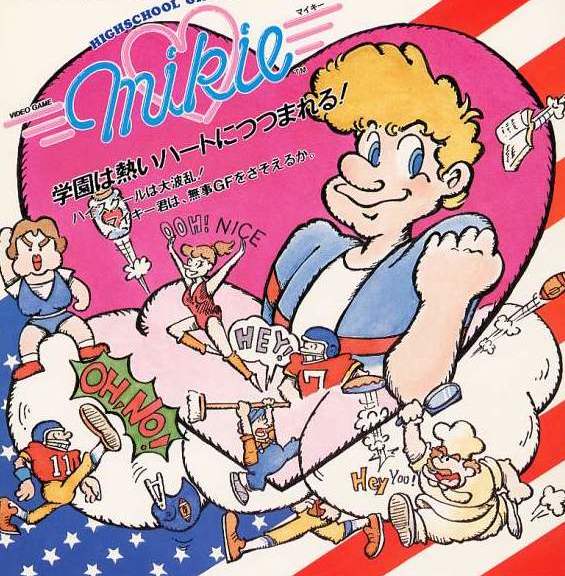
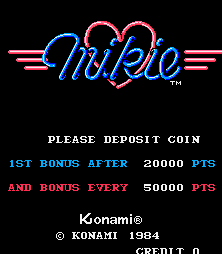
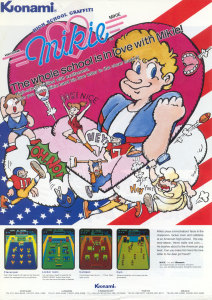



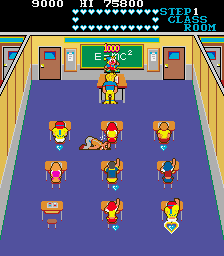
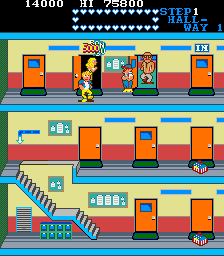






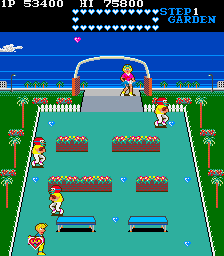
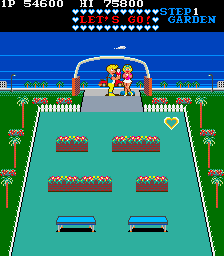
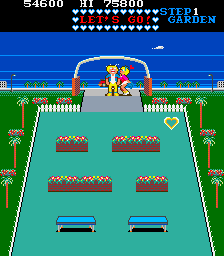

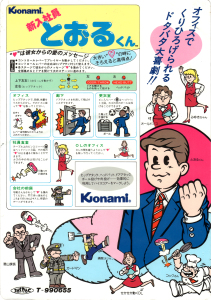
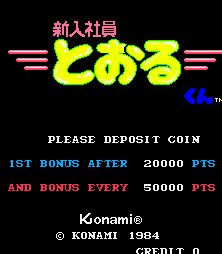



Your theory about Mikie’s localization is actually supported by this Famitsu.com article.
https://www.famitsu.com/cominy/?m=pc&a=page_fh_diary&target_c_diary_id=31514
According to that article, a version of the game with a high school setting did underwent location testing in Japan, but they decided to go for an office setting instead due to an increased incidents of school violence at the time. I can see why they would be concerned, considering the game does involve Mikie kid skipping out on school by headbutting his teacher.
At any rate, I’ve seen the Japanese flyer of Mikie myself before, but I always assumed it was just a re-release of the game. Now that I think about it, I never seen any Japanese conversion kit of Mikie sold online. The version shown on the flyer does differ a bit from any of the released versions. It has the “failure equals success” chalkboard from the later censored version but he still uses headbutts to attack and the fourth level is described as having an additional objective of meeting Mikie’s girlfriend.